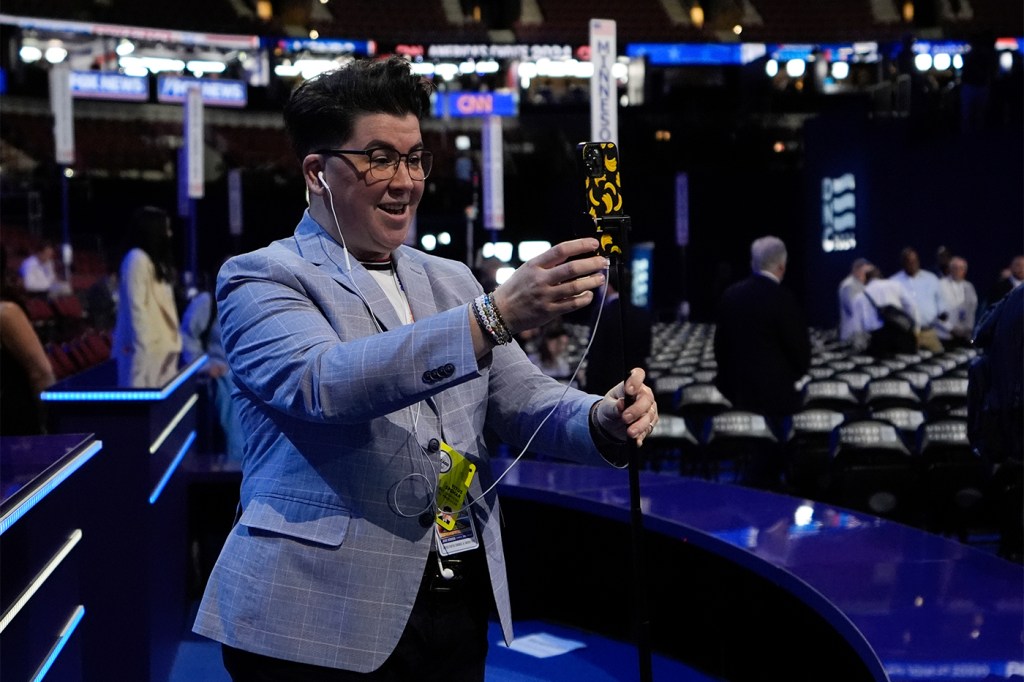Social media invasion: Content creators flood the DNC. Speaking roster includes five influencers
“These are people with an aggregate audience in the tens of millions,” John Wihbey, an associate professor of media innovation and technology at Northeastern University.

The Democratic National Convention is crawling with content creators this week. That’s because DNC organizers have issued more than 200 press credentials to online influencers, promising them “wide-ranging access to events and people traditionally provided only to the press,” according to the New York Times.
That level of access is unprecedented for social media stars at a major party convention, according to the Times. The Republican National Convention also credentialed more than 70 influencers as part of a content creator program designed to attract younger voters.
But the push from both parties to leverage “virality” to reach younger voters, communicate information and shape political narratives is starting to look less like experimental publicity than a campaign norm, experts say.
“These are people with an aggregate audience in the tens of millions,” says John Wihbey, an associate professor of media innovation and technology at Northeastern University. “It’s a no-brainer.”
There are a slew of social media influencers slated to speak during the convention in Chicago, including Nabela Noor, Olivia Julianna, Carlos Eduardo Espina and John Russel, among others — all of whom the Times describes as “millennial and Gen Z influencers.” Their collective reach is more than 24 million social media followers.
The Republican National Convention last month hosted a number of influencers, including model Amber Rose, who alone has 24 million Instagram followers.
“The Democratic Party needs to reach people who are not necessarily reachable through mainstream, traditional channels,” Wihbey says. “I think it’s a great innovation.”
He continues: “These conventions are so scripted and so boring most of the time. I think that anything they can do to let the grassroots in, to spice things up, to make it more interesting and accessible to a broader audience — that’s a great thing.”
What do content creators bring to the table?
Besides large digital audiences, what else do content creators and influencers bring to the table? Wihbey says their presence at the DNC could loosen the script, giving the public an inside look at the goings-on through the varied prisms of individual content creators and influencers. That, he says, is a good thing for “democracy, free speech and robust debate.”
Content creators, too, can sometimes act as stand-ins for the traditional press, Wihbey says. As a Pew Research Center study found that almost half of Americans get some of their news from social media, many content creators and influencers have carved out niches in the news, commentary and journalism spaces.
Wihbey says that content creators are equipped to conduct “acts of journalism, be citizen journalists and provide a watchdog function.”
But as the line between content and news is a blurred one, content creators and influencers can play a role in the spread of misinformation and disinformation. Because content creators — in the context of political events — are more likely to be partisans, the onus is on the viewer to sort fact from fiction.
“People have to judge for themselves the merit and the quality of the content,” Wihbey says.
Featured Posts
Wihbey says the conversation touches on a decades-long debate about “who gets to be a journalist and what constitutes journalism.”
Content creators “can certainly provide a useful function in terms of streaming live from the convention, talking to people and recording those interviews,” he says. “As long as they’re edited in a conscientious and ethical way, that’s great.”
Influencers bring ‘authenticity’
One of the buzzwords that you often hear associated with content creators and influencers in the context of politics is “authenticity.”
“Content creators are a vehicle to reach new audiences, not just through their content, but through their unique ability to speak authentically to their own communities,” Emily Soong, a DNC spokesperson, told the New York Times.
Pullback from traditional media is a predictable consequence of the rise of digital media, which lets campaigns tap directly into ready-made audiences and convey information to voters in a more personalized way, says Katherine Haenschen, a Northeastern political media expert.
New modes of communication are challenging the watchdog role of the press, she says, while also opening up new forms of publicity through “organic content.”
Both candidates have clearly embraced the shift. Since becoming the presumptive Democratic nominee, Vice President Kamala Harris leaned into the “brat summer,” and chose as her running mate Minnesota Gov. Tim Walz, whose ascendance into the national spotlight was largely driven by his social media traction.
Meanwhile, former President Donald Trump has collaborated with the likes of Adin Ross, Logan Paul and others in his bid to appeal to a wider audience. Barron Trump, the youngest of Trump’s five children, is being molded into something of a darling of the conservative Gen Z movement. The 18-year-old reportedly has “presidential merchandise” minted on his behalf for a 2044 election run, when the youngster will be of age to run for high office.
Haenschen says that digital media has reordered candidates’ relationship to the public such that now the line between “opinion leaders” (often the traditional media) and “influencers” (whose target audience is traditionally the consumer) is blurred. That might account for a general shift away from the traditional press toward “friendlier” audiences: long-form podcast conversations and influencer collabs, which serve to bolster candidates’ social media strategy.











